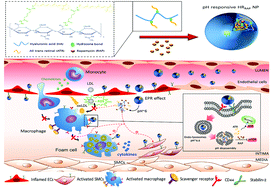Targeted therapy of atherosclerosis by pH-sensitive hyaluronic acid nanoparticles co-delivering all-trans retinal and rapamycin†
Abstract
Atherosclerosis, the leading cause of death in the elderly worldwide, is typically characterized by elevated reactive oxygen species (ROS) levels and a chronic inflammatory state at the arterial plaques. Herein, pH-sensitive nanoparticles (HRRAP NPs) co-delivering all-trans retinal (ATR), an antioxidant linked to hyaluronic acid (HA) through a pH-sensitive hydrazone bond, and rapamycin (RAP), an anti-atherosclerotic drug loaded into the nanoparticle core, are developed for targeted combination therapy of atherosclerosis. In this way, HRRAP NPs might simultaneously reduce ROS levels via ATR antioxidant activity and reduce inflammation via the anti-inflammatory effect of RAP. In response to mildly acidic conditions mimicking the lesional inflammation in vitro, HRRAP NPs dissociated and both ATR and RAP were effectively released. The developed HRRAP NPs effectively inhibited pro-inflammatory macrophage proliferation, and displayed dose- and time-dependent specific internalization by different cellular models of atherosclerosis. Also, HRRAP NP combination therapy showed an efficient synergetic anti-atherosclerotic effect in vitro by effectively inhibiting the inflammatory response and oxidative stress in inflammatory cells. More importantly, HR NPs specifically accumulated in the atherosclerotic plaques of apolipoprotein E-deficient (ApoE−/−) mice, by active interaction with HA receptors overexpressed by different cells of the plaque. The treatment with HRRAP NPs remarkably inhibited the progression of atherosclerosis in ApoE−/− mice which resulted in stable plaques with considerably smaller necrotic cores, lower matrix metalloproteinase-9, and decreased proliferation of macrophages and smooth muscle cells (SMCs). Furthermore, HRRAP NPs attenuated RAP adverse effects and exhibited a good safety profile after long-term treatment in mice. Consequently, the developed pH-sensitive HRRAP NP represent a promising nanoplatform for atherosclerosis combination therapy.



 Please wait while we load your content...
Please wait while we load your content...